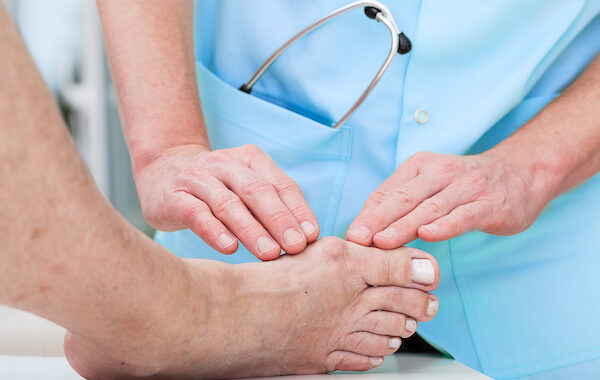All medical practitioners realize how anxious patients can get when they notice something abnormal with their bodies. If you have no idea what is causing the problem, your anxiety will only grow. This could be the case if you see an unusual lump, bump, nodule or protrusion on your feet.
A remarkably wide variety of bumps can afflict our feet. If you have a bump on your foot, you might be wondering what it is and how you got it. Let’s look at some possible reasons.
A bump on foot can indicate various problems, some minor, but others can be rather problematic. So, if you are wondering, “Should I consult a foot and ankle doctor about this bump on my foot?” the answer is yes! If you have a bump on your foot, it is always a good idea to have it examined by a qualified podiatrist to determine what the next course of action should be.
Does the Size of the Foot Bump Indicate Anything?
Foot bumps can vary in size, ranging from the size of a golf ball to the size of a pea. Furthermore, they can be observed on all parts of the foot, including the toes, arch, heel, and ankle. The bump will almost always cause some physical discomfort, but it is not always painful. While the size of the bump can often indicate a condition, it may not be a reliable marker of a specific foot condition.
The Most Common Causes of Foot Bumps
1. The Ganglion Cyst
A soft-tissue mass known as a ganglion cyst (or bible cyst) is the most common type of lump found in feet. This soft, fluid-filled sac (comparable to a tiny water balloon) is a benign protrusion found on both foot joints and tendons. When the capsule enveloping the joint or tendon releases a gelatinous fluid, a cyst of this type may form. The cyst itself may feel solid or squishy, and it may cause mild pain and discomfort.
Cyst aspiration can be used to treat persistent or increasingly painful ganglion cysts. The cyst’s precise location is confirmed using ultrasound, the area is numbed with a local anesthetic, and the thick, jelly-like fluid is drained with a syringe. Although these ganglion cysts are benign, they must be surgically removed by an orthopedic surgeon for a lasting solution. The reason for this is that ganglion cysts can reappear even after being drained.
2. Plantar Fibromas
Plantar fibromas are another common type of foot bump. These are firm and fibrous knots (or nodules) that commonly appear in the foot arch. These bumps are often less than an inch thick, although they can grow larger over time. Like ganglion cysts, plantar fibromas are noncancerous, but they can cause debilitating pain as they enlarge.
Small plantar fibromas with no symptoms generally do not require treatment. However, when symptoms get increasingly painful, there are a few options you can consider. Non-surgical treatments for this condition include cortisone injections (also called corticosteroids or steroid shots), orthotics, and physical rehabilitation. These non-surgical methods may help relieve any discomfort caused by this condition, but they do not always completely get rid of the bump. If you continue to experience pain after non-surgical treatments, you may need to undergo surgery.
3. Bunions
Bunions (also known as hallux valgus) are one of the most common serious foot disorders. A bunion is a bony growth at the base of the big toe, but it can also form on the side of the little toe. The latter is commonly known as a Tailor’s bunion or a bunionette. Bunions form when the joint between the hallux (big toe) and the long metatarsal bones gets misaligned or new bone structure forms. The following factors can also cause bunions:
- Structural abnormalities: Structural abnormalities such as missing or incompletely formed bones, flat feet, or Morton’s toe (shortness and/or hypermobility of the first metatarsal bone). You are also more likely to develop bunions if you have limb-length discrepancy and an abnormal gait.
- Pregnancy: The hormone that helps soften and widen the pelvis during pregnancy, “Relaxin,” can also weaken the foot ligaments. This can result in the bones in the feet spreading out and the arches collapsing.
- High heels: Walking in high-heeled shoes can cause the two main calf muscles — the “gastrocnemius” and “soleus” — to tighten and shift load-bearing towards the front of the foot. The arch may eventually collapse as a result.
You are not alone if you suffer from bunions pain as bunions affect about 3 million people each year. Although this will not bring you any comfort, it is reassuring to know that this progressive disorder is treatable. Bunions are generally treated by switching to more breathable footwear and using shoe inserts or orthotics like arch supports. Again, if these treatment methods fail to fix the problem, you may want to consider surgery.
Can a Bump On Your Foot be Cancerous?
If your orthopedic surgeon suspects that the bump on your feet is cancerous, they will perform a biopsy. The sample cells or tissues are then submitted to a lab, and Magnetic Resonance Imaging (MRI) may be performed to learn more about the bump. If the growth is cancerous, your orthopedic surgeon will surgically remove the bump while working with an oncologist to treat the cancer.
Shop at FootDocStore
Visit the FootDocStore.com online store to find a wide selection of foot pain relief and comfort solutions. Also, be sure to check out our blog to learn more about how to keep your feet and ankles healthy and happy.

